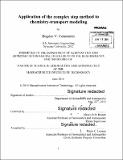Application of the complex step method to chemistry-transport modeling
Author(s)
Constantin, Bogdan V. (Bogdan Valeriu)
DownloadFull printable version (6.153Mb)
Other Contributors
Massachusetts Institute of Technology. Department of Aeronautics and Astronautics.
Advisor
Steven R.H. Barrett.
Terms of use
Metadata
Show full item recordAbstract
Sensitivity analysis in atmospheric chemistry-transport modeling is used to develop understanding of the mechanisms by which emissions affect atmospheric chemistry and composition, to quantify the marginal impact of emissions on air quality, and for other applications including improving estimates of emissions, developing fast first order air quality models, and validating adjoint models. In forward modeling sensitivities have predominantly been calculated using the finite difference approach, i.e. where the results of two separate simulations are subtracted. The finite difference approach incurs truncation and cancellation errors, which mean that exact sensitivities cannot be calculated and even approximate sensitivities cannot always be calculated for a sufficiently small perturbation (e.g. for emissions at a single location or time). Other sensitivity methods can provide exact sensitivities, but require the reformulation of non-linear steps (e.g. the decoupled direct method) or the adjointing of entire codes (partly automatically and partly manually). While the adjoint approach is widely applied and has significant utility in providing source-oriented information, in some applications the receptor-oriented information of forward approaches is needed. Here we apply an alternative method of calculating sensitivities that results in receptor-oriented information as with the finite difference approach, requires minimal reformulation of models, but enables near-exact computation of sensitivities. This approach - the complex step method - is applied for the first time to a complete atmospheric chemistry-transport model (GEOS-Chem). We also introduce the idea of combining complex-step and adjoint sensitivity analysis (for the first time in any context to our knowledge) to enable the direct calculation of near-exact second order sensitivities.
Description
Thesis: S.M., Massachusetts Institute of Technology, Department of Aeronautics and Astronautics, 2014. Cataloged from PDF version of thesis. Includes bibliographical references (pages 33-36).
Date issued
2014Department
Massachusetts Institute of Technology. Department of Aeronautics and AstronauticsPublisher
Massachusetts Institute of Technology
Keywords
Aeronautics and Astronautics.